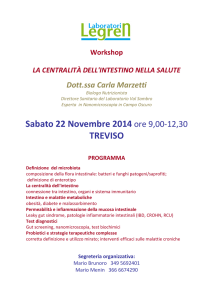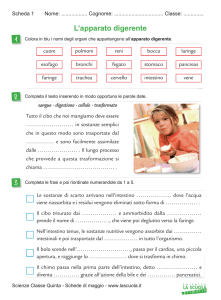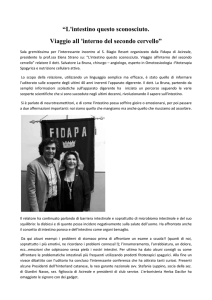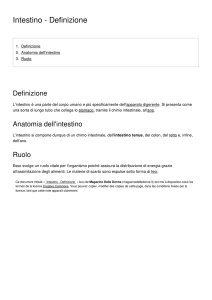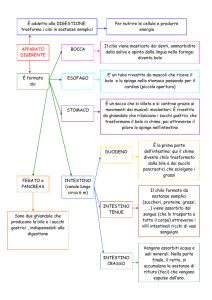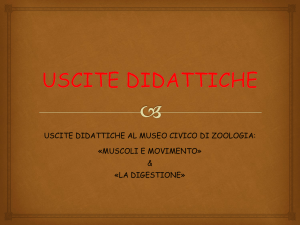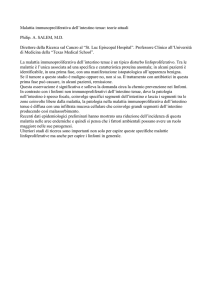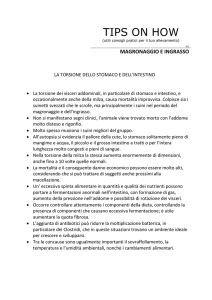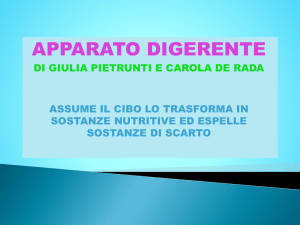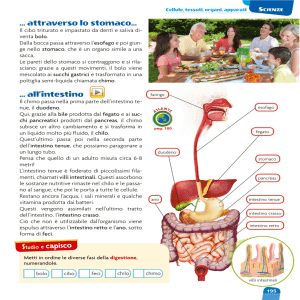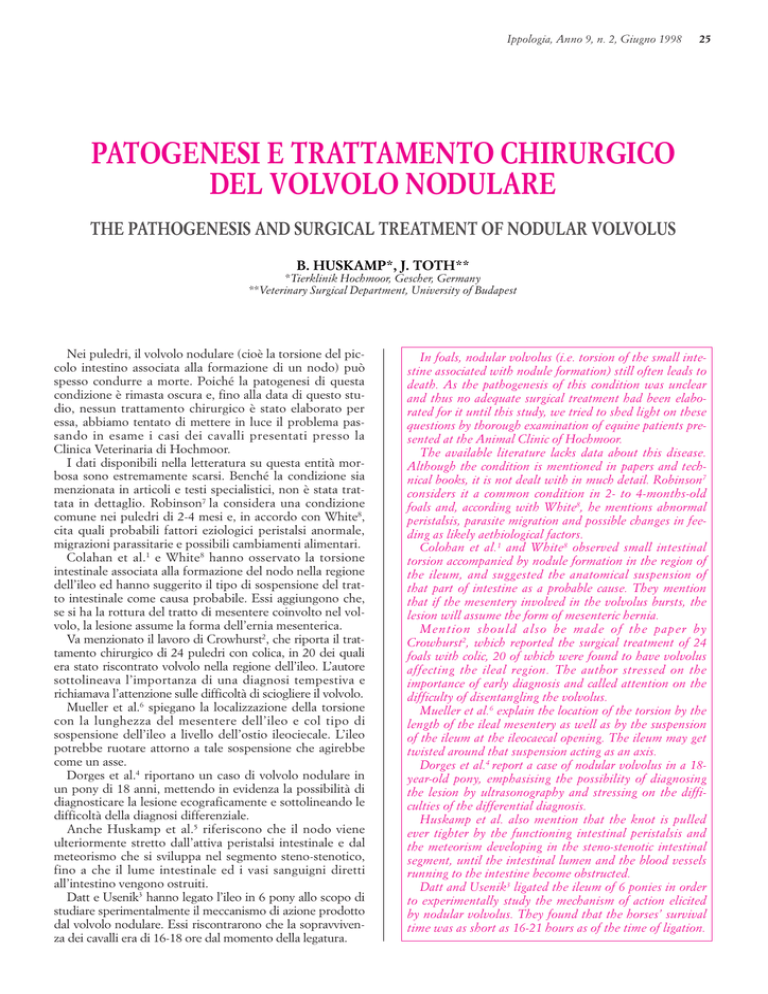
Ippologia, Anno 9, n. 2, Giugno 1998
25
PATOGENESI E TRATTAMENTO CHIRURGICO
DEL VOLVOLO NODULARE
THE PATHOGENESIS AND SURGICAL TREATMENT OF NODULAR VOLVOLUS
B. HUSKAMP*, J. TOTH**
* Tierklinik Hochmoor, Gescher, Germany
* * Veterinary Surgical Department, University of Budapest
Nei puledri, il volvolo nodulare (cioè la torsione del piccolo intestino associata alla formazione di un nodo) può
spesso condurre a morte. Poiché la patogenesi di questa
condizione è rimasta oscura e, fino alla data di questo studio, nessun trattamento chirurgico è stato elaborato per
essa, abbiamo tentato di mettere in luce il problema passando in esame i casi dei cavalli presentati presso la
Clinica Veterinaria di Hochmoor.
I dati disponibili nella letteratura su questa entità morbosa sono estremamente scarsi. Benché la condizione sia
menzionata in articoli e testi specialistici, non è stata trattata in dettaglio. Robinson7 la considera una condizione
comune nei puledri di 2-4 mesi e, in accordo con White8,
cita quali probabili fattori eziologici peristalsi anormale,
migrazioni parassitarie e possibili cambiamenti alimentari.
Colahan et al.1 e White8 hanno osservato la torsione
intestinale associata alla formazione del nodo nella regione
dell’ileo ed hanno suggerito il tipo di sospensione del tratto intestinale come causa probabile. Essi aggiungono che,
se si ha la rottura del tratto di mesentere coinvolto nel volvolo, la lesione assume la forma dell’ernia mesenterica.
Va menzionato il lavoro di Crowhurst2, che riporta il trattamento chirurgico di 24 puledri con colica, in 20 dei quali
era stato riscontrato volvolo nella regione dell’ileo. L’autore
sottolineava l’importanza di una diagnosi tempestiva e
richiamava l’attenzione sulle difficoltà di sciogliere il volvolo.
Mueller et al.6 spiegano la localizzazione della torsione
con la lunghezza del mesentere dell’ileo e col tipo di
sospensione dell’ileo a livello dell’ostio ileociecale. L’ileo
potrebbe ruotare attorno a tale sospensione che agirebbe
come un asse.
Dorges et al.4 riportano un caso di volvolo nodulare in
un pony di 18 anni, mettendo in evidenza la possibilità di
diagnosticare la lesione ecograficamente e sottolineando le
difficoltà della diagnosi differenziale.
Anche Huskamp et al.5 riferiscono che il nodo viene
ulteriormente stretto dall’attiva peristalsi intestinale e dal
meteorismo che si sviluppa nel segmento steno-stenotico,
fino a che il lume intestinale ed i vasi sanguigni diretti
all’intestino vengono ostruiti.
Datt e Usenik3 hanno legato l’ileo in 6 pony allo scopo di
studiare sperimentalmente il meccanismo di azione prodotto
dal volvolo nodulare. Essi riscontrarono che la sopravvivenza dei cavalli era di 16-18 ore dal momento della legatura.
In foals, nodular volvolus (i.e. torsion of the small intestine associated with nodule formation) still often leads to
death. As the pathogenesis of this condition was unclear
and thus no adequate surgical treatment had been elaborated for it until this study, we tried to shed light on these
questions by thorough examination of equine patients presented at the Animal Clinic of Hochmoor.
The available literature lacks data about this disease.
Although the condition is mentioned in papers and technical books, it is not dealt with in much detail. Robinson7
considers it a common condition in 2- to 4-months-old
foals and, according with White8, he mentions abnormal
peristalsis, parasite migration and possible changes in feeding as likely aethiological factors.
Colohan et al.1 and White8 observed small intestinal
torsion accompanied by nodule formation in the region of
the ileum, and suggested the anatomical suspension of
that part of intestine as a probable cause. They mention
that if the mesentery involved in the volvolus bursts, the
lesion will assume the form of mesenteric hernia.
Mention should also be made of the paper by
Crowhurst2, which reported the surgical treatment of 24
foals with colic, 20 of which were found to have volvolus
affecting the ileal region. The author stressed on the
importance of early diagnosis and called attention on the
difficulty of disentangling the volvolus.
Mueller et al.6 explain the location of the torsion by the
length of the ileal mesentery as well as by the suspension
of the ileum at the ileocaecal opening. The ileum may get
twisted around that suspension acting as an axis.
Dorges et al.4 report a case of nodular volvolus in a 18year-old pony, emphasising the possibility of diagnosing
the lesion by ultrasonography and stressing on the difficulties of the differential diagnosis.
Huskamp et al. also mention that the knot is pulled
ever tighter by the functioning intestinal peristalsis and
the meteorism developing in the steno-stenotic intestinal
segment, until the intestinal lumen and the blood vessels
running to the intestine become obstructed.
Datt and Usenik3 ligated the ileum of 6 ponies in order
to experimentally study the mechanism of action elicited
by nodular volvolus. They found that the horses’ survival
time was as short as 16-21 hours as of the time of ligation.
26
Patogenesi e trattamento chirurgico del volvolo nodulare
Aspetti clinici del volvolo nodulare
Clinical features of nodular volvolus
Esaminando i casi di colica presentati presso la Clinica
di Hochmoor, abbiamo riscontrato che il volvolo nodulare
colpisce tipicamente i puledri di età compresa tra i 2 ed i 7
mesi. L’iniziale irrequietezza è presto seguita da colica
grave. In seguito alla dilatazione delle anse intestinali prestenotiche, la massa di piccolo intestino ripiena di gas
causa gonfiore ai fianchi e distensione addominale. Il
dolore addominale acuto non viene alleviato dalla somministrazione di farmaci spasmolitici ed antidolorifici.
I puledri colpiti spesso giacciono in decubito dorsale
perché questo riduce la tensione alla radice del mesentere
ed allevia significativamente il dolore (Fig. 1).
L’esame radiografico e quello ecografico mostrano
entrambi una massa di anse intestinali dilatate.
Un puntato peritoneale raccolto nelle fasi precoci della
condizione è di solito normale. Più tardi, come nel caso di
torsione o strangolamento intestinale, eritrociti e leucociti
compaiono in un liquido peritoneale di volume aumentato.
When examining colicky horses presented at the
Animal Clinic of Hochmoor, we found that nodular volvolus typically occurs in foals between 2 and 7 months of
age. The initial colicky restlessness is soon followed by
severe colic. Due to dilatation of the prestenotic small
intestinal loops, the mass of gas-filled small intestine causes swelling of the flanks and abdominal distension.
Acute abdominal pain cannot be relieved by the administration of spasmolytic or analgesic drugs.
Affected foals often lie in dorsal recumbency for long
periods, because this reduces the tension on the mesentery
root and, thus, relieves the pain significantly (Fig. 1).
Radiography and ultrasonography both show a mass of
dilated intestinal loops.
An abdominal tap taken early in the condition is usually normal. Subsequently, as in the case of small intestinal
torsion or strangulation, erythrocytes and leukocytes
appear in the abdominal fluid of increased volume.
Meccanismo di formazione del volvolo nodulare
Mechanism of the development
of nodular volvolus
Secondo i nostri reperti, il volvolo nodulare si verifica
quasi sempre nella regione dell’ileo, in un’area che consente una torsione di 360° dell’ansa intestinale insieme al
mesentere che le appartiene (Fig. 2). La torsione dell’ansa
intestinale è resa possibile dalla particolare lunghezza del
mesentere ad essa attaccato. Insieme al suo mesentere,
l’intestino ruotato di 360° forma una sorta di tasca aperta
che viene riempita dal digiuno prestenotico adiacente (Fig.
3). Quale risultato della peristalsi propulsiva, l’intestino
contenuto nella “tasca” si riempie di suo contenuto, si
ingrossa e gradualmente spinge l’ileo dal punto che precede la torsione verso la tasca. Questo restringe l’ansa dell’ileo che quindi forma un vero nodo (Fig. 4). Quindi si sviluppa un’ernia interna, in cui la porta erniaria (“anello
erniario” sarebbe forse in questo caso una definizione più
adatta) è costituita dall’ileo, mentre il mesentere forma il
sacco erniario che contiene l’ansa di digiuno (Fig. 5).
Spesso il mesentere (sacco erniario) si rompe e l’ansa di
digiuno incarcerata si trova libera in addome.
According to our findings, nodular volvolus almost
always occurs in the region of the ileum, in areas providing a possibility for a 360° torsion of the intestinal loop
together with the mesentery belonging to it (Fig. 2).
Torsion of the intestinal loop is rendered possible by the
length of the attached mesentery. Together with the attached mesentery, the 360° twisted bowel forms an open
pouch which becomes filled by the adjacent prestenotic
jejunum (Fig. 3). As a result of propulsive peristalsis, the
bowel contained within the “pouch” fills with gut contents, enlarges and gradually pulls the ileum from the site
before the torsion into the pouch. This narrows the ileal
loop, which forms an actual intestinal knot (Fig. 4). Thus
an internal hernia develops, in which the hernial opening
(in this case perhaps “hernial ring” would be a more fitting term) is constituted by the ileum whereas the mesentery forms the hernial sac containing the jejunal loop as
FIGURA 1 - I puledri spesso giacciono in decubito dorsale per lunghi
periodi.
FIGURA 2 - Il volvolo nodulare si verifica quasi sempre nella regione
dell’ileo ed inizia con una torsione intestinale di 360°.
FIGURE 1 - The foals often lie in dorsal recumbency for long periods.
FIGURE 2 - Nodular volvulus almost always occurs in the region of the
ileum and begins with a 360° intestinal torsion.
Ippologia, Anno 9, n. 2, Giugno 1998
Comprendendo il meccanismo con cui si sviluppa il volvolo nodulare, diviene più semplice sciogliere il nodo.
L’esecuzione comprende: primo, massaggiare accuratamente il contenuto dell’ansa steno-stenotica all’indietro
verso il segmento di digiuno prestenotico; quindi il nodo
può essere allentato applicando tensione sul tratto poststenotico; infine, tirando delicatamente sull’intestino prestenotico si può sciogliere il nodo del tutto.
27
an hernial content (Fig. 5).
Often the mesentery (hernial sac) ruptures and the
incarcerated jejunal loop comes to lie loose in the abdomen. If one understands the pathomechanism of the development of nodular volvolus, untying the knot becomes
much easier.
Trattamento chirurgico del volvolo nodulare
Dopo avere effettuato una laparotomia sulla linea
mediana secondo le normali modalità e dopo avere localizzato il volvolo nodulare, va valutata la condizione dell’intestino colpito.
Lo scioglimento atraumatico del nodo è sempre possibile in una lesione recente e quando il tessuto intestinale è
vitale. Nel disfare il nodo, particolare attenzione va rivolta
nel proteggere il mesentere. L’ileo che forma l’anello erniario può essere riconosciuto dalla plica ileocecale situata
prossimalmente e dall’arteria mesenterica ileale distale,
che scorre parallela all’ileo.
Inizialmente si esteriorizza un segmento prestenotico
della lunghezza di 50-100 cm. Un assistente massaggia il
contenuto di questa porzione in direzione orale, partendo
dal nodo. Il chirurgo quindi localizza l’ansa di digiuno incarcerata nella tasca e spinge accuratamente il suo contenuto
nell’intestino prestenotico (Figg. 6 e 7). L’ansa di intestino
steno-stenotica viene svuotata a poco a poco. Quindi la porzione aborale dell’intestino incarcerato viene tirata lentamente e delicatamente fuori dalla tasca attraverso l’apertura
erniaria fino a che il nodo dell’ileo viene sciolto (Fig. 8).
Se l’intestino colpito presenta infarti emorragici ed ha
colore rosso scuro o nero, allora una resezione è inevitabile. In questi casi è bene non perdere tempo nel tentativo di
sciogliere il nodo, ma invece conviene tagliare tutto il
mesentere attaccato all’intestino incarcerato usando le forbici. Il nodo perde la sua tensione e può essere sciolto.
Dopo la resezione dell’intestino necrotico, l’intervento
viene completato da una digiunociecostomia.
FIGURA 4
FIGURA 5
FIGURA 3 - Il lungo mesentere inserito su questo tratto di intestino
viene anch’esso ruotato ed insieme all’intestino forma una tasca aperta
che viene riempita dall’adiacente digiuno prestenotico.
FIGURE 4-5 - L’intestino contenuto nella tasca si riempie di contenuto, si
ingrossa e tira l’ileo dal punto di torsione verso l’interno della tasca.
Questo restringe l’ansa dell’ileo che va a formare un vero nodo intestinale.
FIGURE 3 - The long mesentery attached to this region of bowel is also
twisted and together with the twisted bowel forms an open pouch,
which becomes filled by the adjacent, preestenotic jejunal intestine.
FIGURES 4-5 - The bowel contained within the pouch fills with gut contents, enlarges and pulls the ileum from the site of torsion into the
pouch. This narrows the ileal loop, which forms the actual intestinal knot.
28
Patogenesi e trattamento chirurgico del volvolo nodulare
Bibliografia
1.
2.
3.
4.
5.
6.
7.
8.
Colohan PT, Mayhew JG et al. (1991) Equine Medicine and Surgery. Am.
Vet. Publications, Inc. California.
Crowhurst RG (1970) Abdominal surgery in the foal. Equine Vet. J., 2 (1)
22-26.
Datt SC, Usenik EA (1975) Intestinal obstruction in the horse. Physical
signs and blood chemistry. Cornell Vet., 65 (2) 152-172.
Dorges F, Vornberger K, Stadler P (1993) Sonographische Dartstellung
eines indolenten Volvulus nodosus bei einer Kleinpferdstute.
Pferdeheilkunde, 9 (5) 369-372.
Huskamp B, Daniels H, Kopf N (1982) Magen- und Darmkrankheiten fur
wissenschaft und Praxis. VEB Gustav Fischer Verlag. Jena, 557-559.
Mueller PO, Parks AH, Baxter GM (1992) Small intestinal diseases in horses: diagnosis and surgical intervention. Vet. Med., 1030-1036.
Robinson E (1992) Current Therapy in Equine Medicine 3. W.B. Saunders,
Philadelphia.
White NA (1990) The equine Acute Abdomen. Lea and Febiger,
Philadelphia-London.
FIGURA 6
This is done as follows: first, one carefully massages the
contents of the steno-stenotic bowel loop back into the
prestenotic jejunal segment; then the knot can be loosened by applying tension on the poststenotic bowel, and
finally pulling gently on the prestenotic bowel should
untie the knot completely.
Surgical treatment of nodular volvolus
After performing a median laparotomy in the usual
way and locating the nodular volvolus, the condition of
the affected intestinal segment should be assessed.
Atraumatic untying of the intestinal knot is always possible if the lesion is recent and the intestinal tissue viable.
When disentangling the knot, it is particularly important
to protect the mesentery. The ileum forming the hernial
opening can be recognised by the proximally situated ileocaecal fold and by the distal ileal mesenteric artery which
runs parallel to the ileum.
Initially an about 0.5-1 m. long piece of dilated prestenotic bowel is exteriorised. An assistant massages the contents of this portion of bowel orally, starting at the knot
itself. The surgeon should then locate the jejunal loop
trapped within the pouch and carefully push its contents
into the prestenotic bowel (Figg. 6 and 7). The stenostenotic bowel loop is emptied little by little. Subsequently
the aboral end of the incarcerated intestine is slowly and
gently pulled out of the pouch through the hernial opening until the ileal knot is loosened. Then the prestenotic
bowel loop can easily be pulled out, and the whole knot
thereby opened (Fig. 8).
If the affected intestine has haemorrhagic infarcts and
is dark red or black in colour, then a resection is unavoidable. In such cases one should not waste time trying to
untie the knot, but instead cur through all the mesentery
attached to the incarcerated intestine, using a pair of scissors. The knot then immediately looses its tension and
can be disentangled.
After resection of the necrotic bowel, the surgery is
completed by a jejunocaecostomy.
FIGURA 7
FIGURE 6-7 - Il chirurgo deve localizzare l’intestino incarcerato nella
tasca e spingere delicatamente il suo contenuto nell’intestino prestenotico.
FIGURA 8 - L’ansa di intestino prestenotico può essere facilmente identificata ed il nodo quindi sciolto.
FIGURES 6-7 - The surgeon should locate the intestine trapped within
the pouch and carefully push its contents into the prestenotic bowel.
FIGURE 8 - Then the prestenotic bowel loop can easily be pulled out
and the whole knot thereby opened.

